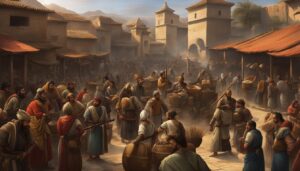
The New Testament, the second division of the Christian biblical canon, provides insights into the historical background of the first-century biblical era. Written in Koine Greek by various authors at different times, the New Testament consists of 27 books, including the four canonical gospels, the Acts of the Apostles, the Pauline epistles, the General Epistles, and the Book of Revelation. These books, penned between 50-100 CE, offer a glimpse into the societal norms, cultures, and politics of the time, creating a historical setting that frames the life and ministry of Jesus, the early days of the Church, and the spread of the gospel message.
Key Takeaways:
- The New Testament provides insights into the historical context of the first-century biblical era.
- Written in Koine Greek, the New Testament consists of 27 books, including the four canonical gospels, the Acts of the Apostles, the Pauline epistles, the General Epistles, and the Book of Revelation.
- The New Testament offers a historical backdrop to the life and ministry of Jesus, the early days of the Church, and the spread of the gospel message.
- Understanding the historical context of the New Testament times is crucial for interpreting and applying its teachings in the present day.
- Studying the New Testament’s historical setting enhances our appreciation for the challenges faced by early Christians and allows us to apply its timeless truths to our lives today.
The Organization of the New Testament
In order to gain a comprehensive understanding of the New Testament, it is important to explore its organization and structure. The New Testament is divided into five major sections, each with its own unique purpose and content. These sections are the Gospels, Acts, the Pauline Epistles, the General Epistles, and the Book of Revelation.
The Gospels
The first section of the New Testament consists of the four Gospels: Matthew, Mark, Luke, and John. These books provide a detailed account of the life, ministry, death, and resurrection of Jesus Christ. They offer unique perspectives and insights into Jesus’ teachings, miracles, and interactions with his disciples and the larger community. The Gospels are foundational to the Christian faith and serve as a primary source of information about the life of Jesus.
Acts
The second section of the New Testament is the Book of Acts. This book documents the early days of the Church, the activities of the apostles, and the spread of Christianity throughout the Roman Empire. It offers a historical account of the growth and development of the early Christian community, providing valuable insights into the challenges and triumphs faced by the early believers.
The Pauline Epistles
The third section of the New Testament consists of the Pauline Epistles, or letters. These letters, traditionally believed to be authored by the apostle Paul, address various churches and individuals, offering guidance and instructions for Christian living. The Pauline Epistles cover a wide range of topics, including theology, ethics, church leadership, and practical matters. They provide valuable insights into the early Christian community and offer timeless wisdom for believers today.
The General Epistles
The fourth section of the New Testament comprises the General Epistles. These letters were written by other early believers, such as James, Peter, John, and Jude, and they address the broader Christian community. The General Epistles offer encouragement, exhortation, and practical advice for living a faithful Christian life. They cover a variety of topics, including faith, love, perseverance, and the challenges of living out the Christian faith in a diverse and changing world.
Book of Revelation
The final section of the New Testament is the Book of Revelation. This book contains letters written to seven specific churches and offers a prophetic interpretation of the future. The Book of Revelation addresses themes of judgment, redemption, and the ultimate victory of God over evil. It provides hope and encouragement to believers, reminding them that God is in control and that their faithfulness will be rewarded.
The organization of the New Testament allows for a comprehensive exploration of the teachings, history, and prophecies contained within its pages. Each section offers unique insights and perspectives, contributing to a rich and diverse understanding of the Christian faith. By studying the organization of the New Testament, we can gain a deeper appreciation for its content and apply its teachings to our lives today.
The Impact and Relevance of the New Testament Today
The New Testament holds immense importance and relevance for believers today. Its teachings and principles serve as a guide for living a Christian life and provide wisdom, inspiration, and encouragement to individuals seeking spiritual growth.
The recorded teachings of Jesus Christ in the Gospels offer a profound framework for understanding God’s love and the way we should relate to others. His teachings on love, forgiveness, compassion, and justice continue to resonate with people of all walks of life, transcending time and cultural boundaries.
Moreover, the epistles found in the New Testament provide practical advice and guidance for navigating the complexities of life. They address various topics such as relationships, personal character, morality, and the pursuit of faith. These letters offer timeless principles that can be applied to our lives today, promoting personal growth and fostering a deeper relationship with God.
Studying the New Testament also allows us to gain insights into the early Christian community. By understanding how they lived out their faith and faced challenges, we can find inspiration and examples to follow in our own journey of faith. The New Testament’s influence extends far beyond its original audience, continuing to impact and transform the lives of believers throughout history.
FAQ
What is the historical context of the New Testament?
The New Testament was written during the first century CE and provides insights into the societal norms, cultures, and politics of that time. Understanding the historical context is essential for interpreting and applying its teachings in the present day.
How is the New Testament organized?
The New Testament is organized into five major sections: the Gospels, Acts, the Pauline Epistles or Letters, the General Epistles, and the Book of Revelation. Each section focuses on specific aspects of Christian teachings and history.
What is the impact and relevance of the New Testament today?
The New Testament serves as a guide for Christian living and a source of wisdom, inspiration, and encouragement. Its teachings and principles are still applicable today and have influenced believers throughout history.








